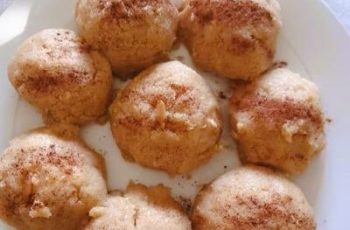Ad Blocker Detected
Our website is made possible by displaying online advertisements to our visitors. Please consider supporting us by disabling your ad blocker. Thank you very much for your support and understanding.
Rice pudding mistakes can really be a headache if you are a beginner.
Picture this: a cozy evening, the sweet aroma of vanilla and cinnamon wafting through your kitchen, and the anticipation of a velvety bowl of rice pudding.
Sounds like a dream, right?
Well, it can be, but all too often, we find ourselves facing rice pudding mishaps that leave us scratching our heads.
Don’t worry; you’re not alone!
In this delightful journey through the world of rice pudding, I will try to uncover the 20 common pitfalls that can turn your dreamy dessert into a culinary conundrum.
From rice varieties to cooking techniques and flavor tweaks, I’ll try to share with you all the do’s and don’ts, so you can whip up a perfect batch of creamy, comforting rice pudding every time.
Let’s dive in!
Rice Pudding Mistakes: 20 Oopsie-Daisy Mistakes You Should Totally Avoid
Below you may find the most common rice pudding mistakes that may ruin your making the best rice pudding experience.
If you take care of these tiny details, nothing would
- Using the wrong type of rice: It’s important to use short-grain rice or specific pudding rice varieties like Arborio or Calrose, as they release starch and create a creamy texture.
- Not rinsing the rice: Failing to rinse the rice can result in excess starch, leading to a stickier pudding.
- Not soaking the rice: Soaking the rice for at least 30 minutes before cooking helps to soften it and ensures even cooking.
- Incorrect rice-to-liquid ratio: Using too much or too little liquid can result in a rice pudding that is either too dry or too watery. Follow the recipe instructions for the right ratio.
- Inadequate cooking time: Rice pudding requires gentle, slow cooking to allow the rice to absorb the liquid and become tender. Rushing the process can result in undercooked grains.
- Insufficient stirring: Stirring the rice pudding regularly prevents it from sticking to the bottom of the pan and ensures even distribution of heat and creaminess.
- Cooking at too high heat: Cooking rice pudding over high heat can cause it to burn or form a crust before the rice is fully cooked. Maintain a low to medium heat throughout the cooking process.
- Adding sugar too early: If you add sugar at the beginning, it may interfere with the rice’s ability to absorb liquid properly. Add sugar towards the end of cooking when the rice is almost done.
- Using low-fat milk: Using low-fat milk can result in a less creamy pudding. Opt for whole milk or a combination of whole milk and heavy cream for a richer texture.
- Overcooking the rice: Overcooked rice can turn mushy and lose its individual texture. Cook the rice until it is tender but still retains some firmness.
- Ignoring flavorings: Rice pudding can benefit from flavorings such as vanilla extract, cinnamon, nutmeg, or even citrus zest. Don’t be afraid to experiment and enhance the taste.
- Adding eggs too early: If your recipe calls for eggs, add them towards the end of cooking to avoid curdling and ensure a smooth consistency.
- Not allowing the pudding to cool: Rice pudding thickens as it cools, so don’t worry if it appears a bit loose while it’s still warm. Allow it to cool for some time before serving.
- Not covering the pudding while chilling: Covering the pudding with plastic wrap or a lid prevents a skin from forming on the surface while it’s chilling in the refrigerator.
- Overcomplicating the recipe: Rice pudding is often enjoyed for its simplicity. Avoid adding too many ingredients or flavors that may overpower the natural taste of the rice.
- Not adding enough liquid: Rice absorbs liquid as it cooks, so it’s important to have enough liquid in the beginning to achieve a creamy consistency.
- Using the wrong pan size: Choosing a pan that is too large can result in a thin layer of rice pudding, while a small pan may lead to uneven cooking.
- Adding cold milk or cream: If your recipe calls for additional milk or cream, make sure it is at room temperature before adding it to the hot rice pudding to prevent temperature shock.
19. Stirring too vigorously: While stirring is essential, avoid vigorous stirring as it can break down the rice grains and result in a mushy texture.
20. Storing the pudding for too long: Rice pudding is best when consumed within a few days. Storing it for an extended period can cause the rice to become dry and lose.
Waow….
It looks like an easy dessert recipe for beginners but if you are not attentive to these tiny details, then you will ruin the whole recipe like my first tries years ago 😎😍
These 20 daisy rice pudding mistakes have been done by me.
To be honest, I had lost all my courage to be able to make delicious rice pudding with the right texture.
I hope my above suggestions would facilitate your rice pudding adventure.
Rice Type Rumble: Why Choosing The Wrong Rice Can Make or Break Your Pudding?
When making rice pudding, it’s critical to choose the right rice type.
Altought rices look so similar, their aroma, their starch level, their ability to absorbe water are so different.
This difference affects the result so much.
When you choose the wrong rice type for your rice pudding, all your efforts may result with disappointment.
So it’s one of big rice pudding mistakes to prefer the wrong rice type.
Let’s see what happens in that case:
“Rice Variety Debate” refers to the discussion surrounding the selection of rice for preparing your rice pudding.
The kind of rice you pick can significantly impact the consistency and overall quality of your rice pudding, which is why it’s frequently emphasized in recipes and culinary conversations.
Selecting the appropriate kind of rice for your rice pudding is pivotal because various rice varieties possess different levels of starch and moisture content, influencing their absorption of liquid and cooking characteristics.
Here are a few commonly used rice types when making rice pudding and how they can affect the final outcome:
- Arborio Rice: Arborio rice, a short-grain rice with a high starch content, is often employed for making risotto and can also be used for rice pudding. Its elevated starch content results in a creamy and smooth texture in the pudding.
- Carnaroli Rice: Similar to Arborio, Carnaroli rice is another short-grain variety utilized in Italian cuisine. It can yield a creamy rice pudding due to its starchiness.
- Medium-Grain Rice: Varieties like Calrose and Bomba, which fall into the medium-grain category, can also be employed for rice pudding. They offer a balance between starch and moisture content, resulting in a creamy yet slightly firmer consistency.
- Long-Grain Rice: Long-grain rice, such as Basmati or Jasmine, contains less starch and more moisture, making it less ideal for rice pudding. However, if you prefer a pudding with distinct individual grains, you might opt for long-grain rice for a different texture.
- Short-Grain Sushi Rice: Sushi rice, commonly used in sushi preparation, can also serve as the foundation for rice pudding. It’s a short-grain rice with a sticky texture that can produce a creamy rice pudding.
The rice selection comes down to your personal taste.
If you desire a richer and thicker rice pudding, select a high-starch rice like Arborio or Carnaroli.
If you favor a lighter and fluffier pudding with separate grains, opt for a medium-grain rice.
Utilizing an unsuitable rice variety, such as long-grain, can lead to an undesired texture, underscoring the importance of choosing the right rice in ensuring the success of your rice pudding.
Ultimately, achieving a delectable rice pudding also hinges on other elements like:
*the cooking technique,
*the rice-to-liquid ratio, and
*the choice of flavorings and seasonings.
Experimenting with various rice varieties can help you find the perfect balance and texture for your preferred rice pudding.
The Sticky Situation: How to Dodge the ‘Gloopy’ Rice Pudding Trap
Well to be honest, this one is tough. 😉
Making rice pudding that’s wonderfully creamy without turning it into a sticky mess is all about getting a few things right.
Let’s break it down with my suggestions for you:
- Pick the Right Rice: First off, choose the correct type of rice, as we discussed earlier. Go for short-grain rice like Arborio or Carnaroli for that extra creaminess. Steer clear of long-grain rice since it tends to make your pudding less appealing.
- Give It a Good Rinse: Before you start cooking, rinse your rice under cold water until the water clears up. This helps remove extra starch from the surface and keeps your pudding from getting too gooey.
- Mind the Liquid: Keep an eye on the rice-to-liquid ratio. Typically, use one cup of rice to two cups of liquid. Adjust it a tad if you need to, but don’t go overboard with the liquid, or you’ll end up with a runny pudding.
- Go for Whole Milk: Whole milk is your best friend here. It adds a creamy touch. If you’re feeling extra indulgent, mix in some heavy cream.
- Slow and Steady Wins: Cook your rice slowly over low to medium-low heat. Stir occasionally to prevent sticking, but don’t go wild with the stirring – too much of it can make the rice grains lose their charm. Low and slow cooking lets the rice soak up the liquid gradually, giving you that dreamy texture.
- Easy on the Sweeteners: Sugar or sweeteners are up to your taste, but start with a bit less than you think you need. You can always toss in more if your sweet tooth demands it. Overly sugary rice pudding can be a bit overwhelming and sticky.
- Spice It Up: Add some extra flavor with a splash of vanilla extract, a pinch of cinnamon or nutmeg, or a touch of salt. These can balance out the sweetness and make your pudding more interesting.
- Egg Yolks, Anyone?: Some recipes suggest adding egg yolks towards the end of cooking. It gives your pudding a smoother, custard-like texture.
- Let It Chill: Allow your rice pudding to cool down a bit before you dig in. It’ll continue to thicken as it cools. If you’re patient, you can pop it in the fridge for a few hours or overnight for an even better texture.
- The Spoon Test: If you’re not sure about the texture, try the spoon test. Dip a spoon into your pudding, and run your finger across the back. If it leaves a clean line without the pudding merging back together, you’re good to go.
So, there you have it!
With my tips and a little experimentation, you’ll be whipping up a delightful rice pudding that’s creamy and not too sticky.
Have fun trying them out to avoid common rice pudding mistakes!
The Creamy Conundrum: Unveiling the Secrets to Achieving Perfect Creaminess
Here are my five different suggestions for achieving perfect creaminess when making your rice pudding and avoiding very common rice pudding mistakes :
- Creamy Delight: To attain ultimate creaminess in your rice pudding, start by choosing the right rice variety. Go for a short-grain rice like Arborio or Carnaroli, as they have the perfect starch content for that silky texture. Avoid long-grain rice, which can lead to a less creamy result.
- The Rinse Ritual: Before cooking, don’t forget to rinse your rice thoroughly under cold water until it runs clear. This helps remove excess surface starch, preventing your pudding from becoming overly gooey.
- Balance is Key: Get the rice-to-liquid ratio just right. A general guideline is one cup of rice to two cups of liquid. Adjust this slightly if needed, but be cautious not to overdo it with the liquid, as this can result in a watery pudding.
- Creamy Elixir: Enhance the creaminess by using whole milk. For an even richer treat, mix in some heavy cream. The extra fat content in these dairy products contributes to a luxurious texture.
- Gentle Cooking Magic: Achieve creaminess through gentle cooking. Simmer the rice over low to medium-low heat, stirring occasionally to prevent sticking. Avoid excessive stirring, which can break down the rice grains. This gradual cooking process allows the rice to absorb the liquid slowly, resulting in a dreamy consistency.
With my five diverse suggestions, I hope you now have a range of techniques to experiment with, ensuring your rice pudding turns out perfectly creamy every time you make it.
Avoiding rice pudding mistakes is no easy job at all! 😉
You May Like This Content As Well 👉👉👉 Easy Rice Pudding Recipe No Egg
My Final Words For 20 Daisy Mistakes You Should Absolutely Avoid
Today I wanted to share with you 20 common rice pudding mistakes which can ruin your rice pudding making joy.
Easy rice pudding recipes-as the name suggests- are really easily doable.
But if you are a beginner in cooking&baking, you will need some tiny secrets to get the best rice pudding for your loved ones.
I hope my tiny secrets to make the best rice pudding and my 20 tips to avoid the common rice pudding mistakes will facilitate your journey.
If you find my article useful, feel free to share it on your social media.
On Twitter I am right there waiting for you: @ guruturkish
I would be more than happy if you follow my Pinterest boards as well right here 👉👉👉 @ turkishfoodpro



